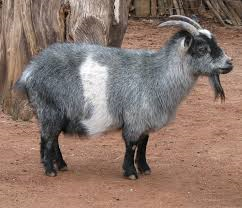Type the name of the breed you're looking for below
[wpdreams_ajaxsearchlite] Don't see the breed your're looking for? Click here and let us know!
Nigerian Dwarf goats
| Place of Origin | West Africa |
| Origin | Nigerian Dwarf Goats are miniature dairy goats from West African. They were originally brought to the United States on ships as food for large cats such as lions, the survivors originally lived in zoos. Nigerian Dwarf goats are popular as pets and family milkers due to their easy maintenance and small stature. However, because of their high butterfat, they are also used by some dairies to make cheese. |
| Purpose | Milk, Pet |
| Characteristics | There are two different height standards for the Nigerian Dwarf goat. The height standard maintained by the American Goat Society and the American Dairy Goat Association requires does to be less than 22.5 inches (57 cm) at the withers, and bucks to be less than 23.5 inches (60 cm) at the withers. The Nigerian Dwarf Goat Association states does should ideally be 17–19 inches (43–48 cm) in height, with a maximum allowed height of 21 inches (53 cm), and bucks should ideally be 19–21 inches (48–53 cm), with a maximum allowed height of 23 inches (58 cm). Nigerian Dwarf Goats come in many colours: white, black, red, cream and patterns such as buckskin (brown with a black cape over the head and neck along with other black markings) and chamoisee (similar to an Oberhasli goat), with or without white spots. Some have white "frosting" on the ears. Although most are naturally horned, generally breeders disbud them at a young age (usually less than 2 weeks of age) for safety to the goat, its herd mates, and humans. Some Nigerian Dwarf goats have blue eyes, which is a dominant trait in goats. Nigerian Dwarfs give a surprising quantity of milk for their size. Their production ranges from one to 8 pounds of milk per day, with an average of 2.5. Since Nigerians breed year-round, it is easy to stagger freshenings (births) in a herd so the entire herd is never dry. Thus, they are ideal milk goats for most families. Their milk has a higher butterfat content than milk from full-sized dairy goats, averaging 6.5% according to the American Dairy Goat Association. Later in lactation, butterfat can go up to 10% or even higher. This makes Nigerian Dwarf goat milk excellent for cheese and soap making. Nigerian dwarf goats' small size also makes them excellent "visitor" animals for nursing homes and hospitals. Some goat supply houses even sell small harnesses and tiny wagons that fit Nigerian dwarf goats. As with all goats, does or neutered males (wethers) make the best pets, as bucks can have an objectionable odor. Nigerian Dwarfs, especially does and wethers, do well with children. Nigerian dwarfs also are easy birthers with very few birthing problems. Nigerian Dwarf goats are gentle and easily trainable. This, along with their small size and colourful appearance, makes them popular as pets. Some breeders bottle-feed kids, which makes them more bonded with humans. Others prefer to let their mothers raise them naturally, finding bottle-fed kids to be overly clingy. With either method, they can be very friendly and can easily be trained to walk on a leash and some enjoy coming into the house with their owners. Adult goats should not live in the house, however, because as ruminants, they need to spend a large part of the day eating hay, pasture, or browse. The most commonly asked question about Dwarf goats is: What is the difference between these and Pygmy goats? Although they have similar origins, they are separate and distinct breeds. Pygmies are bred to be "cobby" and heavy boned. (The best pygmies look like beer kegs with legs.) Dwarves are bred to have the length of body and structure, in proportion, of a dairy goat. Breeders of other types of goats find that their Dwarves blend in with the rest of their herd well and do not need special quarters, just adequate fencing to contain them because of their small size. Dwarf goats breed year round. Many breeders breed their does three times in two years, giving the doe a 6 month plus break. This is of course a personal choice for each breeder. New born kids average about 2 lbs. at birth but grow quickly. They reach sexual maturity at a young age so be sure and separate the bucks and does. Those little guys have been know to breed and be fertile as young as 7 weeks of age. Does can be bred at 7 to 8 months of age if they have reached good size. Some breeders prefer to wait until they are at lest 1 year or older. Dwarf does can have several kids at a time, 3 and 4 being common and sometime even 5. Dwarfs are generally good mothers and able to take care of their babies should you leave them to do the raising of the kids. Bucks are able to be used for service as young as 3 months of age and easily by the time they are 7 or 8 months old. Dwarf bucks are vigorous breeders but are gentle enough to be used for hand breeding or pasture breeding. Both methods are used successfully. |
| Other Considerations | Dwarf goats are registerable in 3 registries. American Goat Society (AGS), International Dairy Goat Registry (IDGR), and Canadian Goat Society (CGS). Dwarf shows are growing in popularity and becoming more and more available. Most are sanctioned by AGS. While the Nigerian Dwarf's numbers are still very small (only 3500 animals are registered in the USA with AGS). |



